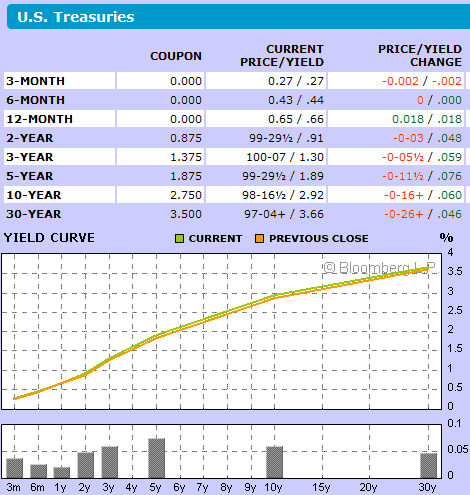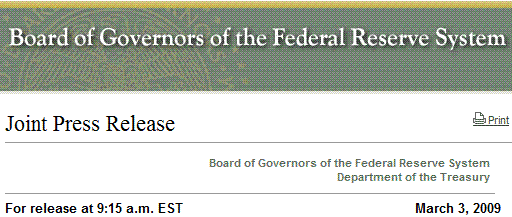Good Morning.
In light trading yesterday, the MBS stack registered token gains but failed to keep pace with the FTQ forced, flattening yield curve (spreads wider). Late in the day TSYs started to give back some of their intraday gains and MBS improved as much 14 ticks. This morning stock markets are feeling optimistic (or just worn out) and MBS's big brother, US Treasuries are losing some of their luster....

...and guess what....the yield curve continues to supervise the behavior of mortgage rates.... and stocks continue to influence TSYs. Therefore stocks are influencing MBS. We like to say the "stock lever is wound tight". (Remember MBS market participants will happily welcome lower MBS dollar prices.) FYI we are well off yesterday's late afternoon highs...so although we are improved from 3pm close yesterday we are still down from 5pm going out levels.
FN30______________________________________
FN 4.5 -------->>>> +0-03 to 100-17 from 100-14
FN 5.0 -------->>>> +0-03 to 101-30 from 101-27
FN 5.5 -------->>>> +0-04 to 102-23 from 102-19
FN 6.0 -------->>>> +0-05 to 103-17 from 103-12
So whats influencing stocks?
For now I am watching Ben Bernanke tiptoe around loaded questions regarding the Obama Administration's Budget (and so forth and so on)...
Here is a copy of the Budget....LINK
Here is Bernanke's Statement: LINK
Here are some excerpts from Ben's statement...
Current economic and financial conditions and the federal budget
Before the Committee on the Budget, U.S. Senate, Washington, D.C.
With the federal funds rate close to zero, the Federal Reserve has focused on alternative tools to ease conditions in credit markets. We have established new lending facilities and expanded existing facilities that aim to enhance the flow of credit to businesses and households...and we introduced the Term Asset-Backed Securities Loan Facility, or TALF, which is designed to facilitate the renewed issuance of consumer and small business asset-backed securities. In addition, to improve the functioning of the mortgage market and to support housing markets and economic activity more broadly, the Federal Reserve has begun to purchase large amounts of agency debt and agency mortgage-backed securities.
Pause from Ben for a minute...
The Federal Reserve and Treasury announced the terms of the TALF this morning...

"The Federal Reserve Bank of New York (FRBNY) will make up to $200 billion of loans under the TALF. TALF loans will have a term of three years; will be non-recourse to the borrower; and will be fully secured by eligible ABS. The U.S. Treasury Department will provide $20 billion of credit protection to the Federal Reserve in connection with the TALF, as described below.
If you would like to read the Terms and Conditions of the TALF...here is a LINK
Key Dates for the TALF
Schedule for First Funding with Initial Eligible Assets
March 3, 2009 Launch of the TALF. Publication of the details for the first funding
March 3-17, 2009 Marketing first funding to investors
March 17, 2009 Subscriptions for first funding for TALF recorded
March 25, 2009 First funds from the TALF disbursed
Schedule for Second Funding
March 24, 2009 Announcement of details of second funding
March 24-April 7, 2009 Marketing second funding to investors
April 7, 2009 Subscriptions for second funding for TALF recorded
April 14, 2009 Second funds from the TALF disbursed
Ok back to Ben....
"Nevertheless, significant stresses persist in many markets. For example, most securitization markets remain closed, and some financial institutions remain under pressure."
"As you are well aware, the Congress recently passed a major fiscal package, which is aimed at strengthening near-term economic activity. The package includes personal tax cuts and increases in transfer payments intended to stimulate household spending, incentives for business investment, federal grants for state and local governments to reduce their need to cut services or cancel building projects, and increases in federal purchases."
"By supporting public and private spending, the fiscal package should provide a boost to demand and production over the next two years as well as mitigate the overall loss of employment and income that would otherwise occur. That said, the timing and the magnitude of the macroeconomic effects of the fiscal program are subject to considerable uncertainty, reflecting both the state of economic knowledge and the unusual economic circumstances that we face."
"The goal of the fiscal package is not just to provide a one-time boost to the economy, but to lay the groundwork for a self-sustaining, broad-based recovery. Whether further funds will be needed depends on the results of the current supervisory assessment of banks, the evolution of the economy, and other factors. The Administration has included a placeholder in its budget for more funding for financial stabilization, should it be necessary."
"Unfortunately, the spending for financial stabilization, the increases in spending and reductions in taxes associated with the fiscal package, and the losses in revenues and increases in income-support payments associated with the weak economy will widen the federal budget deficit substantially this year."
"Taking into account these factors, the Administration recently submitted a proposed budget that projects the federal deficit to increase to about $1.8 trillion this fiscal year and to remain around $1 trillion in 2010 and 2011."
"With such large near-term deficits, it may seem too early to be contemplating the necessary return to fiscal sustainability. To the contrary, maintaining the confidence of the financial markets requires that we begin planning now for the restoration of fiscal balance."
"As I mentioned earlier, the President has recently submitted a budget, and it proposes an ambitious agenda, including new initiatives for energy, health care, education, and tax policy. The Congress will have considerable work in evaluating how to proceed in each of these areas."
"Determining the pace of fiscal normalization will entail some difficult judgments. In particular, the Congress will need to weigh the costs of running large budget deficits for a time against the possibility of a premature removal of fiscal stimulus that could blunt the recovery. We at the Federal Reserve will face similar difficult judgment calls regarding monetary policy."
"As part of that evaluation, it will be critical to consider the formidable challenges and tradeoffs needed to simultaneously achieve an economic and financial recovery, fiscal responsibility, and program reforms that accomplish their desired goals effectively and efficiently."
"In particular, policymakers must remain prepared to take the actions necessary in the near term to restore stability to the financial system and to put the economy on a sustainable path to recovery."
"But the near-term imperative of achieving economic recovery and the longer-run desire to achieve programmatic objectives should not be allowed to hinder timely consideration of the steps needed to address fiscal imbalances. Without fiscal sustainability, in the longer term we will have neither financial stability nor healthy economic growth."
OK... Ben points out that the Obama Administration's budget is ambitious and the Congress will face tough decisions. Basically what he is saying is Congress will need to remain nimble on the issues while the Fed and Treasury walks our $14-$15trillion economy on a TIGHTROPE of near term stability and long term recovery. He doesn't offer up too much on taxes but was sure to remind that the US Government's INCOME was DECLINING and their PAYMENTS were INCREASING....but the Federal Reserve will add a substantial amount of revenue to the Treasury balance sheet via their own balance sheet expansion. Basically Ben is wishing the Congress GOOD LUCK....cause youre gonna need it....buddy.
Speculative Note: 1055 AM. Bernanke noticeably stumbles when saying banks are "viable". Anyone hear the gentleman from Vermont during the Q&A session? Wow....
Opinion: none of this matters until toxic assets are out of the picture

Consensus Estimate: -3.0%
The Pending Home Sales Index,1 a forward-looking indicator based on contracts signed in January, fell 7.7 percent to 80.4 from a downwardly revised reading of 87.1 in December, and is 6.4 percent below January 2008 when it was 85.9. The index is at the lowest level since tracking began in 2001, when the index value was set at 100.
WORSE THAN EXPECTED...
Lawrence Yun, NAR chief economist, said the downturn in the economy also weighed heavily on the data. "Even with many serious potential home buyers on the sidelines waiting for passage of the stimulus bill, job losses and weak consumer confidence were a natural drag on home sales," he said. "We expect similarly soft home sales in the near term, but buyers are expected to respond to much improved affordability conditions and from the $8,000 first-time buyer tax credit."
BUT....BORROWERS/BUYERS LISTEN UP HERE...
NAR's Housing Affordability Index rose 13.6 percentage points in January to 166.8, a new record high. The HAI, a broad index of affordability using consistent values and assumptions over time, shows that the relationship between home prices, mortgage interest rates and family income is the most favorable since tracking began in 1970.
TIIIMMMAAAAAAY speaks at 12:30 before the House Ways and Means Committee.
Automakers announce earnings (hahahahah earnings) today...





